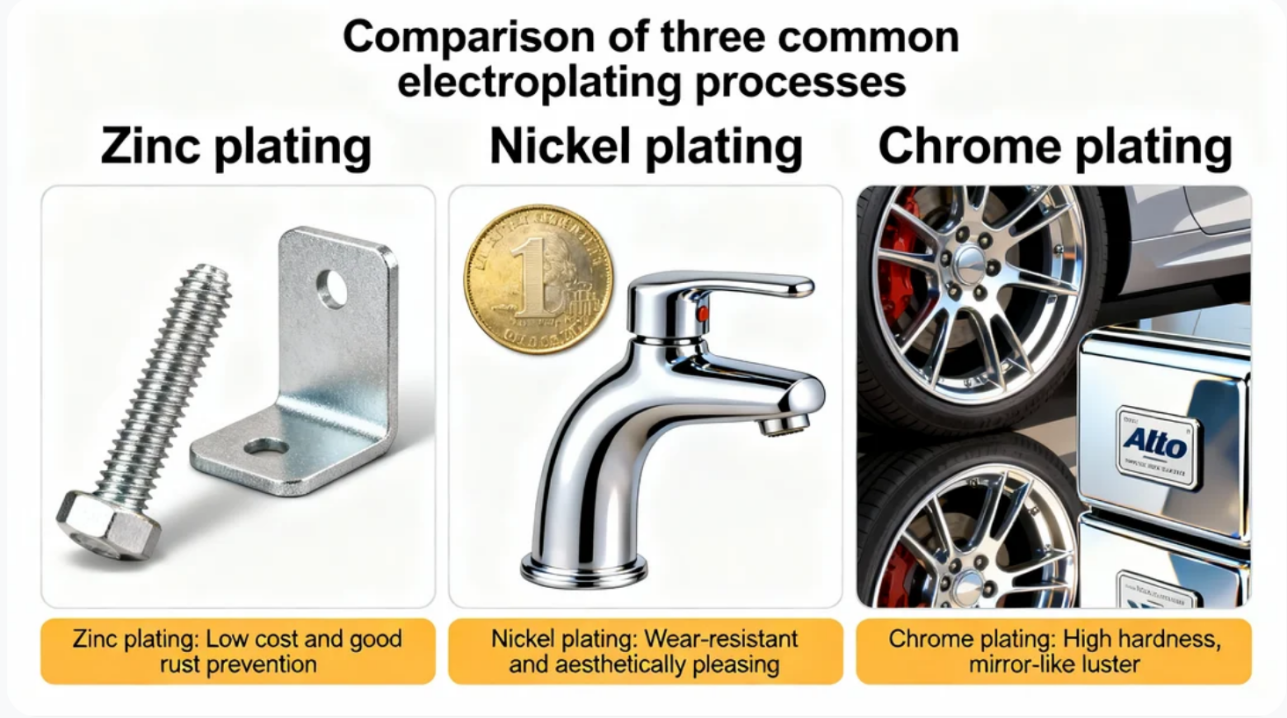When it comes to electroplating, we need to first understand what it really is. Simply put, electroplating is the process of using the principle of electrolysis to deposit a thin layer of other metals or alloys on a metal surface.
This is not for the sake of appearance, but more importantly, it can prevent oxidation and rust, while improving the surface’s wear resistance, conductivity, and corrosion resistance. Of course, the appearance can also be improved.
There are many types of electroplating, including copper plating, gold plating, silver plating, chrome plating, nickel plating, and zinc plating. In the manufacturing industry, zinc plating, nickel plating, and chrome plating are particularly widely used. What is the difference between the three of them? Let’s take a look one by one.
Zinc plating
Zinc plating is the process of coating a layer of zinc on the surface of metal or other materials, primarily for rust prevention and aesthetic purposes.
The characteristics are low cost, decent corrosion resistance, and silver white color.
Commonly used on cost sensitive and rust resistant components such as screws, circuit breakers, and industrial products.
Nickel plating
Nickel plating is the process of depositing a layer of nickel on the surface through electrolysis or chemical methods.
Its characteristics are that it has a beautiful appearance, can be used for decoration, the craftsmanship is slightly more complex, the price is also relatively high, and the color is silver white with a hint of yellow.
You will see it on energy-saving lamp heads, coins, and some hardware.
Chrome plating
Chrome plating is the process of depositing a layer of chromium on the surface. Chrome itself is a bright white metal with a hint of blues.
Chrome plating is mainly divided into two types: one is decorative, with a bright appearance, wear resistance, and rust prevention slightly worse than zinc plating but better than ordinary oxidation; The other is functional, with the aim of increasing the hardness and wear resistance of the parts.
The shiny decorations on household appliances and electronic products, as well as tools and faucets, often use chrome plating.
The basic differences among the three
Chrome plating is mainly used to increase hardness, aesthetics, and rust prevention. The chemical properties of the chromium layer are stable and do not react in alkali, nitric acid, and most organic acids, but they are sensitive to hydrochloric acid and hot sulfuric acid. It does not change color, has long-lasting reflective ability, and is stronger than silver and nickel. The process is usually electroplating.
Nickel plating focuses on wear resistance, corrosion resistance, and rust prevention, and the coating is generally thin. There are two types of processes: electroplating and chemistry.
So if the budget is tight, choosing zinc plating is definitely the right choice; If you pursue better performance and appearance, you have to consider nickel plating or chrome plating. Similarly, hanging plating is usually more expensive than rolling plating in terms of process.
Post time: Nov-21-2025





